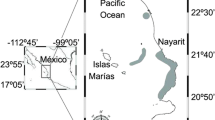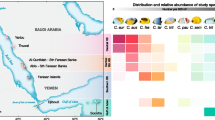Synopsis
Regional Indo-Pacific fish faunas were examined for broad patterns in species size composition. An analysis of the New Guinea fauna, based on data compiled by Munro (1967), revealed that (i) maximum body size for a species tended to be larger in the more advanced teleost families; (ii) intrafamilial size variation (expressed by the standard deviation of log-transformed maximum body size) was significantly lower in the suborder Percoidei than in families drawn from broader taxonomic groupings; and (iii) size variation was significantly positively correlated with mean maximum body size and, in the percoids only, with the number of species in a family. An analysis of Marshall Islands reef fish assemblages, based mainly on the data of Matt & Strasburg (1960), indicated, that (i) mean maximum body size varied significantly between habitats and feeding categories, and tended to increase with openness of habitat and with trophic level; (ii) size variation within feeding categories increased with the number of species, but not significantly so; and (iii) confamilial species generally exhibited close similarities in terms of preferred habitats, trophic levels and foraging modes. These findings indicate that interspecific body size variation is both phylogenetically and ecologically constrained. Size variation within ecological categories (especially habitats) was much greater than within families. Thus, confamilial species generally did not exhibit the range of body sizes theoretically open to members of their habitat feeding guilds. The results are also consistent with aspects of resource-partitioning theory, notably that resource-utilisation breadth should increase with the number of coexisting species.
Similar content being viewed by others
References cited
Anderson, G.R.V., A.H. Ehrlich, P.R. Ehrlich, J.D. Roughgarden, B.C. Russell & F.H. Talbot. 1981. The community structure of coral reef fishes. Amer. Nat. 117: 476–495.
Berg, L.S. 1940. Classification of fishes both recent and fossil. Trav. Inst. Zool. Acad. Sci. USSR, 5(2); reprinted 1947 by J.W. Edwards, Ann Arbour. 517 pp.
Calder, W.A. III. 1984. Size, function and life history. Harvard University Press, Cambridge. 431 pp.
Carcasson, R.H. 1977. A field guide to the reef fishes of tropical Australia and the Indo-Pacific region. Collins, London. 320 pp.
Case, T.J. 1979. Optimal size and an animal's diet. Acta Biotheor. 28: 54–69.
Dunham, A.E. & D.B. Miles. 1985. Patterns of co-variation in life history traits of squamate reptiles: the effects of size and phylogeny reconsidered. Amer. Nat. 126: 231–257.
Ehrlich, P.R. 1975. The population biology of coral reef fishes. Ann. Rev. Ecol. Syst. 6: 211–247.
Felsenstein, J. 1985. Phylogenies and the comparative method. Amer. Nat. 125: 1–15.
Fowler, C.W. & J.A. MacMahon. 1982. Selective extinction and speciation: their influence on the structure and functioning of communities and ecosystems. Amer. Nat. 119: 480–498.
Gatz, A.J. 1979a. Community organisation in fishes as indicated by morphological features. Ecology 60: 711–718.
Gatz, A.J. 1979b. Ecological morphology of freshwater stream fishes. Tulane. Stud. Zool. 21: 91–124.
Gerritson, J. 1984. Size efficiency reconsidered: a general foraging model for free swimming aquatic animals. Amer. Nat. 123: 450–467.
Greenwood, P.H., D.E. Rosen, S.H. Weitzman & G.S. Myers. 1966. Phyletic studies of teleostean fishes, with a provisional classification of living forms. Bull. Amer. Mus. Nat. Hist. 131: 339–456.
Hiatt, R.W. & D.W. Strasburg. 1960. Ecological relationships of the fish fauna on coral reefs of the Marshall Islands. Ecol. Monog. 30: 65–127.
Hutchinson, G.E. & R.H. MacArthur. 1959. A theoretical ecological model of size distributions among species of animals. Amer. Nat. 93: 117–125.
Keast, A. 1985. The piscivore feeding guild of fishes in small freshwater ecosystems. Env. Biol. Fish. 12: 119–129.
Kerr. S.R. 1974. Theory of size distribution in ecological communities. J. Fish. Res. Board Can. 31: 1859–1862.
Lauder, G.V. & K.F. Liem. 1983. The evolution and interrelationships of the Actinopterygian fishes. Bull. Mus. Comp. Zool. 150: 95–197.
Lynch, M.A. 1977. Fitness and optimal body size in zooplankton populations. Ecology 58: 763–774.
Masuda, H., K. Amaoka, C. Araga, T. Uyeno & T. Yoshino. 1984. The fishes of the Japanese archipelago. Tokai University Press, Tokyo. 437 pp.
May, R.M. 1981. Patterns in multispecies communities. pp. 197–227. In: R.M. May (ed.) Theoretical Ecology: Principles and Applications. Blackwell, Oxford.
Munro, I.S.R. 1967. The fishes of New Guinea. Department of Agriculture, Stock and Fisheries, Port Moresby. 650 pp.
Patrick, R. 1975. Stream communities. pp. 445–459. In: M.L. Cody & J.M. Diamond (ed.) Ecology and Evolutin of Communities, Harvard University Press, Cambridge.
Peters, R.H. 1986. The ecological implications of body size. Cambridge University Press, Cambridge. 352 pp.
Robertson, D.R. & B. Lassig. 1980. Spatial distribution patterns and co-existence of a group of territorial damselfish from the Great Barrier Reef. Bull. Mar. Sci. 30: 187–203.
Roff, D. 1981. On being the right size. Amer. Nat. 118: 405–422.
Roughgarden, J. 1974. Species packing and the competition function with illustrations from coral reef fish. Theor. Popul. Biol. 5: 163–186.
Roughgarden, J. 1976. Resource partitioning among competing species — a co-evolutionary approach. Theor. Popul. Biol. 9: 388–424.
Sale, P.F. 1979. Recruitment, loss and co-existence in a guild of territorial reef fishes. Oecologia (Berl.) 42: 159–177.
Schmitt, R.J. & S.J. Holbrook. 1984. Gape limitation, foraging tactics and prey size selectivity of two microcarnivorous species of fish. Oecologia (Berl.) 63: 6–12.
Schoener, T.W. 1969. Models of optimal size for solitary predators. Amer. Nat. 103: 277–313.
Schoener, T.W. 1974. Resource partitioning in ecological communities. Science 185: 27–39.
Simberloff, D. 1983. Sizes of co-existing species. pp. 404–430. In: D.J. Futuyma & M. Slatkin (ed.) Co-evolution, Sinauer, Sunderland.
Smith, C.L. 1975. Analysis of a coral-reef fish community: size and relative abundance. Hydro-Lab Journal 3: 31–38.
Smith, C.L. 1978. Coral reef fish communities: a compromise view. Env. Biol. Fish. 3: 109–128.
Sokal, R.R. & F.J. Rohlf. 1981. Biometry. W.H. Freeman & Co., San Francisco. 859 pp.
Stanley, S.M. 1973. An explanation for Cope's Rule. Evolution 27: 1–26.
Unger, P.A. & W.M. Lewis, Jr. 1983. Selective predation with respect to body size in a population of the fish Xenomelaniris venezuelae(Atherinidae). Ecology 64: 1136–1144.
Warwick, R.M. 1974. Species size distribution in marine benthic communities. Oecologia (Berl.) 61: 32–41.
Watson, D.J. & E.K. Balon. 1984. Ecomorphological analysis of fish taxocenes in rainforest streams of northern Borneo. J. Fish Biol. 25: 371–384.
Author information
Authors and Affiliations
Rights and permissions
About this article
Cite this article
Warburton, K. Ecological and phylogenetic constraints on body size in Indo-Pacific fishes. Environ Biol Fish 24, 13–22 (1989). https://doi.org/10.1007/BF00001606
Received:
Accepted:
Issue Date:
DOI: https://doi.org/10.1007/BF00001606




